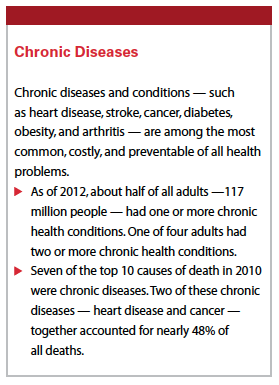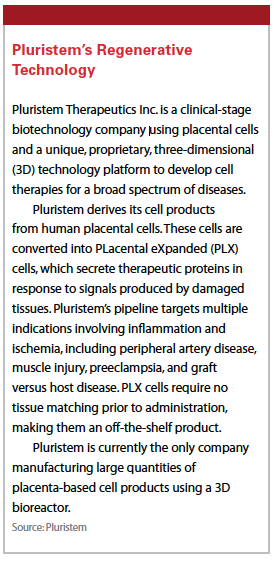A Unique Approach to Regenerative Medicine
 Karine Kleinhaus, M.D., Divisional VP, North America, Pluristem Therapeutics, discusses how the emerging wave of regenerative and cell therapies could potentially improve the longevity and quality of life of patients living with chronic diseases.
Karine Kleinhaus, M.D., Divisional VP, North America, Pluristem Therapeutics, discusses how the emerging wave of regenerative and cell therapies could potentially improve the longevity and quality of life of patients living with chronic diseases.
PV: Why is the incidence of chronic disease increasing?
Kleinhaus: There are a few reasons, some of which are good and others not so good. In the Western world, there are more older people as a percentage of the population. The types of chronic diseases that are more common in the elderly are increasing. In addition, the rates of diabetes and obesity are increasing in Western populations and these also bring about risk factors for chronic diseases.
PV: What are the opportunities for regenerative medicines in the realm of chronic diseases?
Kleinhaus: The opportunities are huge. Essentially, regenerative medicines trigger the body’s cells to enhance mechanisms for healing. For example, in a recent trial around muscle injury we have shown that after a muscle is cut during surgery, it healed significantly better where regenerative cells were introduced versus a placebo.
PV: What products in your pipeline are you excited about?
Kleinhaus: Right now we have two products at the forefront, each is for a different indication. PLX-PAD, our first product, is in clinical trials for multiple therapeutic indications.
This product targets inflammation and pushes body to use its own mechanisms to grow new blood vessels. What’s really exciting is that we were selected for the adaptive pathways project in Europe, which gives us guidance and support to apply for conditional approval after a Phase II study. This is a wonderful opportunity for a company our size and stage of clinical development and will allow us to cut down on years and millions of dollars of additional trials.
This same product was found to be very effective in muscle injury. And we have other ongoing trials in diseases where blood flow to the legs is obstructed and in severe pulmonary disease.
PLX-R18 (RAD), our second product, is in preclinical development for hematological indications and acute radiation exposure (ARS). This product targets dysfunction in bone marrow, and we are looking to see if we can help increase the success of bone marrow transplants. Another indication is for acute radiation syndrome. The U.S. government is looking at our cells for a potential indication for that kind of catastrophe.
PV: What is your evaluation of the chronic disease market?
Kleinhaus: Generally speaking, there are many efforts going on to develop new approaches to many chronic diseases, including diabetes where there is a lot of research being done, as well as cancer and immune diseases, which require new and innovative treatments.
In our case, if our Phase II trials are successful in Europe, we could anticipate marketing in 2018, which would be specifically for critical limb ischemia, a disease of the leg that affects blood flow. As part of the disease there is risk of gangrene and amputation and very high risk of death. Within a year of diagnosis, 20% of people die and 30% have amputation. It’s a very severe disease without great options. There are 1 million patients in the United States suffering from critical limb ischemia, and close to 700,000 in Europe.
The indications that we target and a lot of what regenerative medicines target are chronic severe diseases that don’t have great treatment options. Our focus is on critical limb ischemia and bone marrow diseases.
Other regenerative companies are targeting stroke and other diseases. We’re all thinking about how regenerating tissue can help the body function properly in context of these diseases. (PV)
~~~~~~~~~~~~~~~~~~~~~~~~~
Chronic Diseases
 Chronic diseases and conditions — such as heart disease, stroke, cancer, diabetes, obesity, and arthritis — are among the most common, costly, and preventable of all health problems.
Chronic diseases and conditions — such as heart disease, stroke, cancer, diabetes, obesity, and arthritis — are among the most common, costly, and preventable of all health problems.
As of 2012, about half of all adults —117 million people — had one or more chronic health conditions. One of four adults had two or more chronic health conditions.
Seven of the top 10 causes of death in 2010 were chronic diseases. Two of these chronic diseases — heart disease and cancer — together accounted for nearly 48% of all deaths.
Source: Centers for Disease Control and Prevention
Pluristem’s Regenerative Technology
Pluristem Therapeutics Inc. is a clinical-stage biotechnology company using  placental cells and a unique, proprietary, three-dimensional (3D) technology platform to develop cell therapies for a broad spectrum of diseases.
placental cells and a unique, proprietary, three-dimensional (3D) technology platform to develop cell therapies for a broad spectrum of diseases.
Pluristem derives its cell products from human placental cells. These cells are converted into PLacental eXpanded (PLX) cells, which secrete therapeutic proteins in response to signals produced by damaged tissues. Pluristem’s pipeline targets multiple indications involving inflammation and ischemia, including peripheral artery disease, muscle injury, preeclampsia, and graft versus host disease. PLX cells require no
tissue matching prior to administration, making them an off-the-shelf product.
Pluristem is currently the only company manufacturing large quantities of placenta-based cell products using a 3D bioreactor.
Source: Pluristem










